Legal Paternity Test
In a standard DNA paternity test, the DNA of a child is tested against the father to determine whether there is a biological relationship. A Legal Paternity test simply means there is a chain of custody which proves that all individuals tested are who they claim to be, and the result is admissible in court.
Of course some “children” are adults.
Painless
Samples for most DNA Paternity tests are collected with a painless cheek swab. A swab is rubbed in each cheek to collect cells from which the lab extracts a DNA profile. The DNA profiles are compared and if there are enough that match, the lab can determine whether the individuals are related.
Alternative samples
In some circumstances, DNA can be extracted from toothbrushes, cigarette butts, clothing, finger nails, blood, ear wax and bed sheets. If you are not sure, please ask.
How a DNA Paternity Test works
What a DNA Paternity Test Tells You
A DNA Paternity Test clearly determines whether a man is the biological father of a child. Laboratories perform legal paternity tests according to the strict standards set by the American Association of Blood Banks (AABB). These tests analyze 22 Short Tandem Repeat (STR) human genetic markers to evaluate the biological relationship.
Each child inherits half of their DNA from their mother and the other half from their father. Therefore, a biological parent must share one allele with the child on each of these markers. By comparing these alleles, the lab determines whether a biological relationship exists.
If the laboratory determines that the DNA of the alleged father does not match the child’s DNA, the results will state that he is “excluded as the father of the child.” In this case, the probability of paternity is 0.00%.
On the other hand, if the laboratory finds a DNA match between the alleged father and the child, the report will state that he “cannot be excluded as the father of the child.” This conclusion results from statistical analysis that produces a Combined Paternity Index (CPI) greater than 100. As a result, the test indicates a probability of paternity greater than 99%, which meets the legal threshold required by U.S. courts to declare a man as the biological father.

